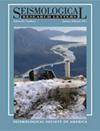Paleoseismic Earthquake Recurrence Interval Derivation for the 2022 Revision of the New Zealand National Seismic Hazard Model
IF 3.2
3区 地球科学
Q2 GEOCHEMISTRY & GEOPHYSICS
引用次数: 3
Abstract
Abstract Recurrence intervals of ground-surface rupturing earthquakes are one of numerous datasets used to constrain the rates of fault ruptures in the 2022 revision of the New Zealand National Seismic Hazard Model (NZ NSHM 2022). Paleoearthquake timing and single-event displacement (SED) data in the New Zealand Paleoseismic Site Database version 1.0 alongside geologic and geodetic slip rates from the New Zealand Community Fault Model version 1.0 and NZ NSHM 2022 Geodetic Deformation Model were used to estimate recurrence intervals on faults across New Zealand for inclusion in the NZ NSHM 2022. Past earthquake timings were fit with lognormal, exponential, and Brownian Passage Time recurrence models to derive probability density functions (PDFs) of mean recurrence interval (MRI) in a Bayesian framework. At some sites, SED and slip-rate (SR) data were used to estimate PDFs of MRI; and at sites where timings, slip rate, and displacement data are available, the timings-based and slip-based PDFs were combined to develop tighter constraints on MRI. Using these approaches, we produce a database of maximum-likelihood MRIs and their uncertainties for 80 sites across New Zealand. The resulting recurrence interval dataset is publicly available and is the largest such dataset in New Zealand to date. It provides a valuable resource for future seismic hazard modeling and highlights areas that would benefit from future study.新西兰国家地震危险性模型2022年修订版的古地震地震重现区间推导
在2022年修订的新西兰国家地震灾害模型(NZ NSHM 2022)中,地表破裂地震的复发间隔是用于约束断层破裂率的众多数据集之一。利用新西兰古地震现场数据库1.0版中的古地震时间和单事件位移(SED)数据,以及新西兰社区断层模型1.0版和NZ NSHM 2022大地形变模型中的地质和大地滑动率,估计了新西兰各地断层的复发间隔,以便纳入NZ NSHM 2022。用对数正态、指数和布朗时间递归模型拟合过去的地震时间,在贝叶斯框架下推导平均递归区间(MRI)的概率密度函数。在一些部位,使用SED和滑移率(SR)数据来估计MRI的pdf;在可获得时间、滑移率和位移数据的地点,将基于时间和基于滑移的pdf相结合,以制定更严格的MRI约束。使用这些方法,我们为新西兰的80个地点制作了一个最大可能性核磁共振成像及其不确定性的数据库。由此产生的复发间隔数据集是公开可用的,是迄今为止新西兰最大的此类数据集。它为未来的地震灾害建模提供了宝贵的资源,并强调了将从未来的研究中受益的领域。
本文章由计算机程序翻译,如有差异,请以英文原文为准。
求助全文
约1分钟内获得全文
求助全文
来源期刊

Seismological Research Letters
地学-地球化学与地球物理
CiteScore
6.60
自引率
12.10%
发文量
239
审稿时长
3 months
期刊介绍:
Information not localized
 求助内容:
求助内容: 应助结果提醒方式:
应助结果提醒方式:


